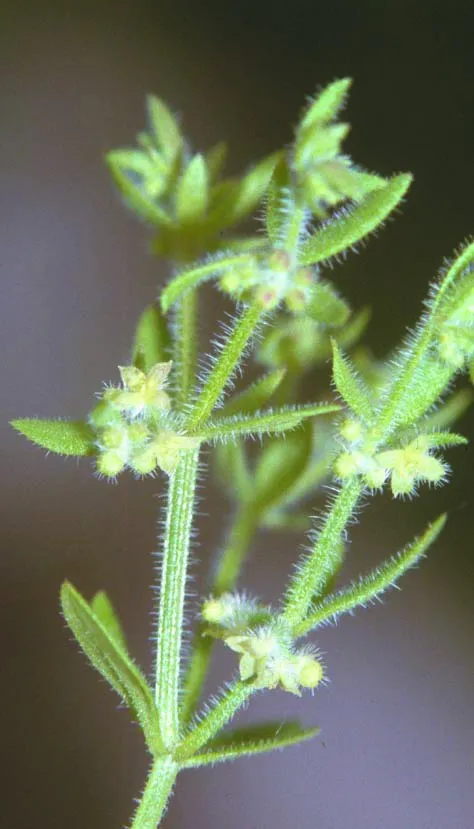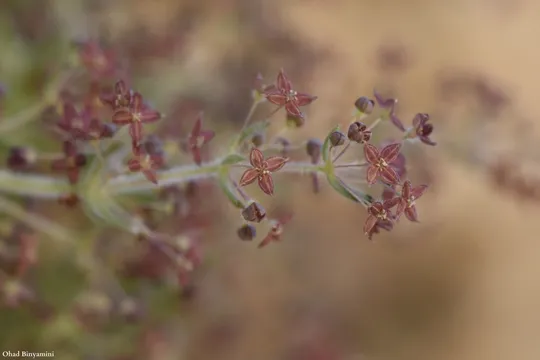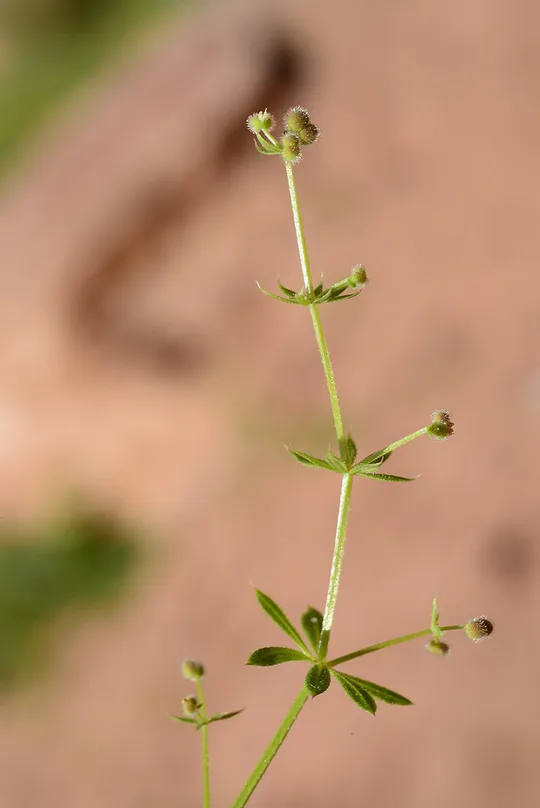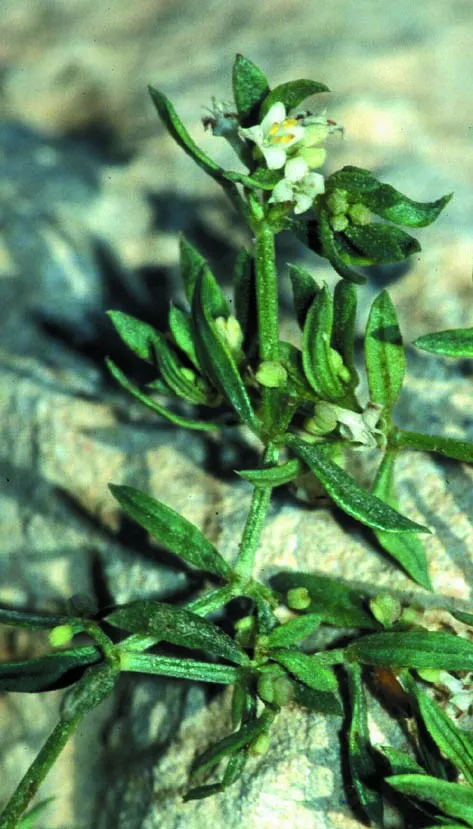Jericho Bedstraw
Galium hierochuntinum

Bornmueller first discovered Galium hierochuntinum in 1898 in Jericho. It grows in four adjacent regions: the Jordan Valley, the Samarian transition zone, the Judean Desert and the Dead Sea shore. In fact, its distribution is limited to a strip 75 km in length from Ǧiftlik in the Jordan Valley to the mouth of the Kidron at the Dead Sea. G. hierochuntinum grows at the bottom of the slopes descending from the northern Judean Mountains and the southern Samarian Mountains to the Jordan Valley. In other words, its limited range crosses four different regions, but in each region, it only populates a small area. Some of the major sites from which it was collected include Um-Zuka, Ma’ale Efraim, The Jordan Valley Monument , Jericho, Wadi Qelt, En Prat, Mishor Adumim, above Qumran, Ras Feshha and Mezin Ruins. In the Flora Palaestina the species is also noted from the Arava and Danin (2004) notes it also from the upper Jordan Valley, but there is no evidence to support these claims.
In the shadow of rocks
on steep slopes and gorges in the warm lower zone of slopes descending to the
Dead Sea Valley.
For the genus, see Galium
chaetopodum.
G. hierochuntinum is a rare endemic species, which apparently speciated from G. judaicum in the warm canyons of the Judean Desert,
Moab and the Samaria transition zone. The two species are very similar with their soft hairy foliage. However, while in G.
judaicum the leaves are arranged in whorls of 4-8 leaves, in G. hierochuntinum the number of leaves on each whorl is 2-4.
G. judaicum has broad, ovate or elliptic leaves, unlike the narrow leaves of G. hierochuntinum. In
Wadi Qelt both
species can be found: G. judaicum grows in the upper section and G. hierochuntinum
in the lower section. When two species grow together, there
are no intermediate forms. Feinbrun (1976) divided the species into two
varieties: the hierochuntinum variety, where the flower and pedicel are hairy and the fruit has long bristly white hairs that cover the flower, and the papillosum variety, where the flower and the pedicel are smooth and the fruit mericarp is covered with tiny
nipple like nodes.
Regarding the chorotype we followed Feinbrun 1976 and wrote "east - Saharo-Arabian",
because G. hierochuntinum grows in
the Dead Sea area, where the dominating vegetation is Saharo-Arabic (=desert). However, according
to Greenberg-Fertig (1966) and Zohary (1973) G. hierochuntinum is
attributed a western-Irano-Turanian chorotype,
because it is taxonomically
related to the Irano-Turanian species. These researchers
stress the origin of the species when determining the biological species chorotype.
·
No rare plant survey was
conducted in the range of Galium
hierochuntinum. Existing data indicate that it is found in 15 sites in
4 close regions.
·
On
most of the sites it
is not protected. It is protected only in Wadi Qelt and in
the Um-Zuka Reserve.
The sites where Galium hierochuntinum grows on the Dead Sea shore, in the Jordan
Valley and in the Samarian transition zone should be mapped. Two sites, in Wadi Qelt and near theJordan
Valley Monument should be closed off, to control grazing and
to demographically monitor the populations.
Galium hierochuntinum is endemic to Israel and Jordan. Its
precise distribution in Jordan is unknown; its range extends from Wadi Shwayeb to
the Arnon Canyon (Danin, 2004). It is also found in Edom, according to Baierle
(1993).
Galium
hierochuntinumi is an annual species, endemic to Israel and Jordan, first
described from the mouth of Wadi Qelt near Jericho. Its
global distribution is very limited, and includes only the slopes descending to the northern Dead
Sea and lower Jordan Valley on
both sides of the rift. The
populations are small, but not very vulnerable as it grows between rocks, cliffs and deep gorges that are
not easily accessible. Its attractiveness is also negligible. G. hierochuntinum has been classified as a red plant mainly
because it is an endemic species whose distribution area is very small, and it
is characteristic of the entire biota (unique
on a global scale) of the Dead Sea Basin.
Current Occupancy Map
| 1000 squre meter pixel | 5000 squre meter pixel | 10000 squre meter pixel | |
|---|---|---|---|
| number of observations | 0 | 0 | 0 |
| in total pixels | 0 | 0 | 0 |
| Family | Rubiaceae |
| Classification | On the near threatened species list |
| Ecosystem | Desert |
| Chorotype | Endemic (Eastern –Saharo-Arab) |
| Conservation Site | En Qelt, En Fu'ar |
| Rarity |
1
2
6
|
|---|---|
| Vulnerability |
0
0
4
|
| Attractiveness |
0
0
4
|
| Endemism |
0
2
4
|
| Red number |
1
2.1
10
|
| Peripherality | 0 |
| IUCN category | DD EW EX LC CR EN VU NT |
| Threat Definition according to the red book | Near threatened |
 Based on:
Based on:






